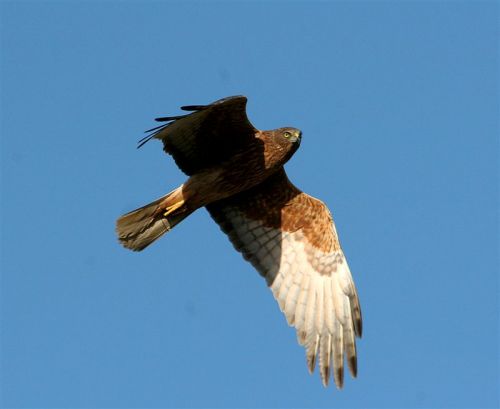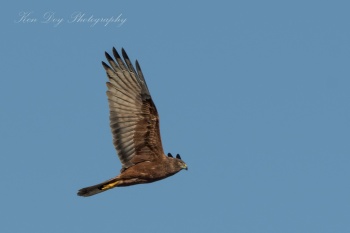(taxonomy) |
Sbarnhardt (talk | contribs) (Edited username Mzungu to Ken Doy x 1 & image pixel to 500px) |
||
| (6 intermediate revisions by 4 users not shown) | |||
| Line 1: | Line 1: | ||
| − | [[ | + | [[Image:Swamp_Harrier.jpg|thumb|500px|right|Photo © by {{user|Gallus|Gallus}}<br />Swan Lake, [[Victoria]], [[Australia]], October 2005]] |
| + | '''Alternative name: Australian Harrier''' | ||
;[[:Category:Circus|Circus]] approximans | ;[[:Category:Circus|Circus]] approximans | ||
| − | |||
==Identification== | ==Identification== | ||
| − | + | 48–61 cm (19-24 in) | |
| + | *Dark brown overall plumage, becoming lighter with age | ||
| + | *White rump. | ||
| + | Females larger than males. | ||
==Distribution== | ==Distribution== | ||
| − | Australasia. Breeds in southern [[New Guinea]], [[Australia]], [[New Zealand]] and on many Pacific islands including the [[Society Islands]], [[Tonga]], the [[Fiji]] Islands from Kandavu to the Lau Archipelago, Vanuatu (reported on Aneiteum, Tanna, Erromanga, Efate and Santo), the [[Loyalty Islands]] and [[New Caledonia]], Lifu and Uvea. Widespread in Australia, particularly in the north, east and south-east, but also in the south-western corner and can occur throughout most of the country except the more arid regions of the interior. [[China]] and in Hokkaido and Honshu in [[Japan]]. Also occurs in [[Tasmania]] where a summer visitor. In New Zealand breeds on North and South Islands and a straggler south to the Auckland and Campbell Islands. | + | [[Image:Swamp Harrier-1.jpg|thumb|350px|right|Immature<br />Photo © by {{user|Ken+Doy|Ken Doy}}<br />Atkinsons Dam, [[Queensland]], [[Australia]], July 2020]] |
| + | [[Australasia]]. Breeds in southern [[New Guinea]], [[Australia]], [[New Zealand]] and on many Pacific islands including the [[Society Islands]], [[Tonga]], the [[Fiji]] Islands from Kandavu to the Lau Archipelago, Vanuatu (reported on Aneiteum, Tanna, Erromanga, Efate and Santo), the [[Loyalty Islands]] and [[New Caledonia]], Lifu and Uvea. | ||
| + | |||
| + | Widespread in Australia, particularly in the north, east and south-east, but also in the south-western corner and can occur throughout most of the country except the more arid regions of the interior. [[China]] and in Hokkaido and Honshu in [[Japan]]. Also occurs in [[Tasmania]] where a summer visitor. | ||
| + | |||
| + | In New Zealand breeds on North and South Islands and a straggler south to the Auckland and Campbell Islands. | ||
==Taxonomy== | ==Taxonomy== | ||
| − | This is a [[Dictionary_M- | + | This is a [[Dictionary_M-O#M|monotypic]] species |
| − | Pacific Marsh Harrier (Swamp Harrier) is treated as a race of Marsh Harrier ''C. aeroginosus'' by some authors | + | Pacific Marsh Harrier (Swamp Harrier) is treated as a race of [[Western Marsh Harrier]] ''C. aeroginosus'' by some authors |
==Habitat== | ==Habitat== | ||
Open country, crops, paddyfields and swamps. | Open country, crops, paddyfields and swamps. | ||
==Behaviour== | ==Behaviour== | ||
| − | + | ====Diet==== | |
| − | + | Their diet consists mostly of small mammals, birds and eggs, reptiles, amphibians, fish, large insects and carrion. | |
| − | + | ====Breeding==== | |
| − | + | The nest on the ground, often in swamps, constructing a platform nest from sticks, reeds and dried grass. In amongst reeds or other dense vegetation. The clutch contains 3-4 eggs which are incubated for about 33 days, with chicks fledging about 45 days later. | |
| + | ==References== | ||
| + | #{{Ref-Clements6thAug19}}#Debus, S. and G. M. Kirwan (2020). Swamp Harrier (Circus approximans), version 1.0. In Birds of the World (J. del Hoyo, A. Elliott, J. Sargatal, D. A. Christie, and E. de Juana, Editors). Cornell Lab of Ornithology, Ithaca, NY, USA. https://doi.org/10.2173/bow.swahar1.01 | ||
| + | {{ref}} | ||
==External Links== | ==External Links== | ||
{{GSearch|Circus+approximans}} | {{GSearch|Circus+approximans}} | ||
| − | + | [[Category:Birds]] [[Category:Circus]] | |
| − | [[Category: | ||
Revision as of 15:26, 9 December 2020
Alternative name: Australian Harrier
- Circus approximans
Identification
48–61 cm (19-24 in)
- Dark brown overall plumage, becoming lighter with age
- White rump.
Females larger than males.
Distribution
Australasia. Breeds in southern New Guinea, Australia, New Zealand and on many Pacific islands including the Society Islands, Tonga, the Fiji Islands from Kandavu to the Lau Archipelago, Vanuatu (reported on Aneiteum, Tanna, Erromanga, Efate and Santo), the Loyalty Islands and New Caledonia, Lifu and Uvea.
Widespread in Australia, particularly in the north, east and south-east, but also in the south-western corner and can occur throughout most of the country except the more arid regions of the interior. China and in Hokkaido and Honshu in Japan. Also occurs in Tasmania where a summer visitor.
In New Zealand breeds on North and South Islands and a straggler south to the Auckland and Campbell Islands.
Taxonomy
This is a monotypic species
Pacific Marsh Harrier (Swamp Harrier) is treated as a race of Western Marsh Harrier C. aeroginosus by some authors
Habitat
Open country, crops, paddyfields and swamps.
Behaviour
Diet
Their diet consists mostly of small mammals, birds and eggs, reptiles, amphibians, fish, large insects and carrion.
Breeding
The nest on the ground, often in swamps, constructing a platform nest from sticks, reeds and dried grass. In amongst reeds or other dense vegetation. The clutch contains 3-4 eggs which are incubated for about 33 days, with chicks fledging about 45 days later.
References
- Clements, J. F., T. S. Schulenberg, M. J. Iliff, S. M. Billerman, T. A. Fredericks, B. L. Sullivan, and C. L. Wood. 2019. The eBird/Clements Checklist of Birds of the World: v2019. Downloaded from http://www.birds.cornell.edu/clementschecklist/download/
- Debus, S. and G. M. Kirwan (2020). Swamp Harrier (Circus approximans), version 1.0. In Birds of the World (J. del Hoyo, A. Elliott, J. Sargatal, D. A. Christie, and E. de Juana, Editors). Cornell Lab of Ornithology, Ithaca, NY, USA. https://doi.org/10.2173/bow.swahar1.01
Recommended Citation
- BirdForum Opus contributors. (2024) Swamp Harrier. In: BirdForum, the forum for wild birds and birding. Retrieved 19 April 2024 from https://www.birdforum.net/opus/Swamp_Harrier





